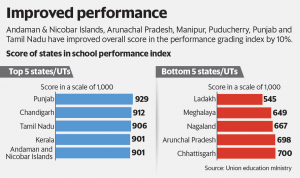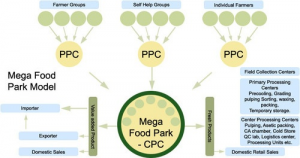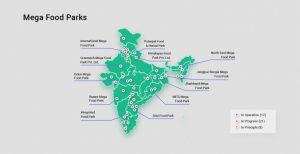Topics
- Performance Grading Index
- New Pension Rules
- World Neglected Tropical Diseases Day (NTD)
- Model Panchayat Citizens Charter
- Mega Food Parks Scheme
- Performance Grading Index
Context: Union Ministry of Education recently release Performance Grading Index for the year 2020-21.
Key Details:
- According to the index, most of the states and UTs have improved their grade in PGI 2019-20 compared to earlier years.
- Punjab, Chandigarh, Tamil Nadu, Andaman and Nicobar Islands, and Kerala occupy the highest grade A++ in 2019-20 in the field of school education.
- Delhi, Gujarat, Haryana, Rajasthan, Puducherry, Dadra and Nagar Haveli are in the A+ category.
- The grading index analyses the performance of states on 70 different parameters.
- Punjab has scored the maximum points for governance and management; Bihar and Meghalaya have scored the lowest in terms of infrastructure and facilities.
- Andaman and Nicobar Islands and Odisha have shown marked improvements in the infrastructure domain between 2019-20 and 2018-19, indicating that the states and union territories have started to take action for improving their infrastructure and facilities, albeit by varying extent.
- Thirteen states and UTs have shown improvement by 10 per cent in the domain of infrastructure and facilities, the report said.
- Governance and management and infrastructure of schools remain key concerns in several states.
- For the first time, one state (Punjab) has scored more than 90% in governance, but there are states such as Nagaland and Chhattisgarh which have scored less than 50%.
- Bihar and Meghalaya, recorded the lowest scores in the infrastructure and facilities domain. This is a cause for concern as a proper school building with adequate facilities is a must to improve the overall quality of school education.
- Indicators such as availability of information and communication technology facilities and timely availability of textbooks and uniforms, which are critical inputs for better performance of students and mentioned in the Right to Education Act, are measured in the infrastructure and facilities domain.

About PGI:
The PGI for states and union territories was first published in 2019 with reference year 2017-18. The PGI for 2019-20, released on Sunday, is the third publication in this series.
- The PGI exercise aims at encouraging states and Union territories to undertake multipronged interventions that will bring about optimal education outcomes.
- The PGI is structured in two categories, outcomes and governance and management, and comprises 70 indicators on aggregate, with a maximum score of 1,000.
- Through the PGI, the shortfalls like shortage of teachers, principals and administrative staff, lack of regular supervision and inspection, inadequate training of the teachers, timely availability of finances (all of which are captured in the governance and management domain) can be measured objectively and regularly. This is crucial for taking necessary steps to eliminate the gaps.
- The index helps the states and UTs to pinpoint the gaps and accordingly prioritise areas for intervention to ensure that the school education system is robust at every level.
- The PGI provides grades to the states and Union territories, as opposed to ranks. Grading, by allowing several states and Union territories to be considered at the same level, eliminates the phenomenon of one improving only at the cost of others, which casts a stigma of underperformance on the latter.
- New Pension Rules
Context: Recently, the Central Government has amended its pension rules putting new restrictions on officials of intelligence and security organisations after retirement.
Background:
What are the existing provisions?
- The pension of government servants is already subject to their conduct after retirement.
- Rule 8 of the CCS Pension Rules says: “Future good conduct shall be an implied condition of every grant of pension and its continuance
- The appointing authority may, by order in writing, withhold or withdraw a pension or a part thereof, whether permanently or for a specified period, if the pensioner is convicted of a serious crime or is found guilty of grave misconduct.
Key Points on new amendment:
- The government has amended Rule-8(3)(a) of the CCS (Central Civil Services) Pension Rules-1972.
- The Centre has notified Central Civil Services (Pension) Amendment Rules, 2020.
- The said rules were first drafted in 1972 and have been amended 47 times.
- Under amended Rule-8(3)(a), no government servant, who, having worked in any intelligence or security-related organisation included in the Second Schedule of the RTI Act, shall, without prior clearance from the Head of the Organisation, make any publication after retirement, of any material relating to and including:
- domain of the organisation, including any reference or information about any personnel and his designation, and experience or knowledge gained by virtue of working in that organisation
- sensitive information, the disclosure of which would prejudicially affect the sovereignty and integrity of India, the security, strategic, scientific or economic interests of the state, or relation with a foreign state or which would lead to incitement of an offence.”
- The Department of Personnel and Training under the Ministry of Personnel, Public Grievances and Pensions introduced this condition as a substitute clause in rules on pension subject to future good conduct.
- The Second Schedule of the RTI Act covers 26 organisations including the Intelligence Bureau, R&AW, Directorate of Revenue Intelligence, CBI, NCB, BSF, CRPF, ITBP and CISF.
- This change in rules is likely to impact retired officials of security and intelligence organisations who write in newspapers and magazines or author books on their former organisations and experiences.
Purpose of the Amendment:
- The amendment was in process for around four years after the Committee of Secretaries recommended it.
- The move was prompted by concerns arising out of the fact that some high-profile retired officers had written books on their tenure, and some of these had revealed information.
Rules Pertaining to Government Servants
- Rule 9 of CCS Pension Rules-1972 (Departmental Proceeding after Retirement):
- It says that if any government official has committed any misconduct and retires, he or she may face departmental proceedings only until four years after the date of committing that misconduct.
- On the other hand, Central Civil Services (Conduct) Rules, 1964 puts some restrictions on Government Employees while in Service.
- Rule 7: It restricts government servants from resorting to or abetting any form of strike or coercion.
- Rule 8: It restricts them, except with government sanction, from owning or participating in the editing or management of any newspaper or other periodical publication or electronic media.
Restriction on Political Activity while in Service:
- The Conduct Rules bars government servants from being associated with any political party or organisation, and from taking part or assisting any political activity.
- An amendment in 2014 said, “Every government employee shall at all times maintain political neutrality” and “commit himself to and uphold the supremacy of the Constitution and democratic values”
Is a retired government servant restricted from taking up employment?
- Rule 26, Death-cum-Retirement Benefits Rules, restricts a pensioner from any commercial employment for one year after retirement, except with previous sanction of the central government.
- Non-compliance can lead the central government declaring that the employee “shall not be entitled to the whole or such part of the pension and for such period as may be specified”.
- This cooling-off period was two years until 2007, when an amendment reduced it to one year.
Politics after Retirement
- Thereis no rule to stop government servants from joining politics after their retirement.
- In 2013, the Election Commission had written to the DoPT (Department of Personnel and Training) and Law Ministry, suggesting a cooling-off period for bureaucrats joining politics after retirement, but it was rejected.
- The Legislative Department of the Ministry of Law advised “that any such restriction (against officials joining politics or contesting polls) may not stand the test of valid classification under Article 14 (equality before the law) of the Constitution of India”.
Organisations under the Second Schedule of the RTI Act are:
- The Intelligence Bureau, Research and Analysis Wing, Directorate of Revenue Intelligence, Central Economic Intelligence Bureau, Directorate of Enforcement, Narcotics Control Bureau, Aviation Research Centre, Special Frontier Force, Border Security Force, Central Reserve Police Force, Indo-Tibetan Border Police, Central Industrial Security Force, National Security Guards, Assam Rifles, Sashastra Seema Bal (formerly Special Service Bureau), Special Branch (CID), Andaman and Nicobar, Crime Branch-CID-CB, Dadra and Nagar Haveli, Special Branch, Lakshadweep Police, Special Protection Group, Defence Research & Development Organisation, Border Road Development Board, and Financial Intelligence Unit.
- CBI was later added by an amendment to RTI act.
- World Neglected Tropical Diseases Day (NTD)
Context: Recently, delegates at the 74th World Health Assembly adopted a proposal to declare January 30 as ‘World Neglected Tropical Diseases (NTD) Day’.
Key Details:
- The proposal to recognise the day was floated by the United Arab Emirates. It was adopted unanimously by the delegates.
- A major milestone in the movement to recognise the global burden of these diseases was the London Declaration on NTDs that was adopted January 30, 2012.
- Officials from the World Health Organization (WHO), the World Bank, the Bill and Melinda Gates Foundation, representatives from leading global pharmaceutical companies as well as representatives of several national governments met at London’s Royal College of physicians to pledge to end the diseases.
- The first World NTD Day was celebrated informally in 2020. This year, the new NTD road map was launched January 28.
- NTD’s and their intricate interrelationships with poverty and ecological systems continue to cause devastating health, social and economic consequences.
What are Neglected Tropical Diseases?
- Neglected Tropical Diseases are a group of infections that are mainly found in economically weaker communities in Africa, Asia and in Americas.
- They are caused by pathogens like viruses, bacteria, protozoa and parasitic worms. Little priority is given for research and treatment against these infections.
- According to the World Health Organisation’s estimates, more than a billion people are affected by these diseases across the world.
- These diseases generally receive less funding for research and treatment than malaises like tuberculosis, HIV-AIDS and malaria.
- Some examples of NTDs include snakebite envenomation, scabies, yaws, trachoma, Leishmaniasis and Chagas disease.
- Spread:
- Infections are caused by unsafe water, poor housing conditions and poor sanitation.
- Children are the most vulnerable to these diseases, which kill, impair or permanently disable millions of people every year, often resulting in life-long physical pain and social stigmatization.
- Several NTDs can be controlled by drug treatment (preventive chemotherapy), on a country or community scale, via mass drug administration programmes. Other NTDs require different approaches and strategies for control or elimination, including specialised drugs and/orvector control (limiting or eradicating insects-e.g. flies and bugs-that transmit the pathogens).
The WHO’s new road map for 2021–2030 calls for three strategic shifts to end NTDs:
- From measuring process to measuring impact.
- From disease-specific planning and programming to collaborative work across sectors.
- From externally driven agendas reliant to programmes that are country-owned and country-financed.
Why are they called Neglected Tropical Diseases?
- The NTDs are named so because the attention on these diseases has been the least while they affect the most number of poor people.
India & Neglected Tropical Diseases:
- According to the World Health Organization report of 2017, India was able to eliminate Leprosy in 82% of the cities and districts.
- The Ministry of Health and Family Welfare also mentioned that India has eradicated Infectious Trachoma along with the chronic disease Yaws from the country.
- The most common NTDs in India are Lymphatic Filariasis, Visceral Leishmaniasis, Rabies, Leptospirosis, Dengue and Soil-Transmitted Helminthic Infections (STH).
- As per WHO data, India ranks number 1 in the number of cases for many major NTDs in the world.
Government’s Initiatives towards Neglected Tropical Diseases:
- National Rabies Control Programme: It provides vaccination to stray dogs and free vaccines through Government Hospitals all over the country.
- National Vector Borne Disease Control Programme: It is a comprehensive programme for the prevention and control of vector-borne diseases namely Malaria, Filaria, Kala-azar, Japanese Encephalitis (JE), Dengue and Chikungunya.
- National Leprosy Eradication Programme: The programme was launched with the goal of elimination of leprosy as a public health problem. In 2005, it was officially declared eliminated as a public health concern in India. Yet, India accounts for the largest number of leprosy-affected people in the world.
- The National Policy on Treatment of Rare Diseases: Mostly focuses on identifying and researching treatments for rare diseases and infectious tropical diseases.

Declared NTDs:
WHO Infographics on NTD’s:
- Model Panchayat Citizens Charter
Context: Recently, Ministry of Panchayati Raj(MoPR) released a Model Panchayat Citizens Charter
Key Details:
- The citizen’s charter is a voluntary and written document that outlines the service commitment of organizations or service providers towards providing quality, high-standard services, including mechanisms for grievance redressal.
- Ministry of Panchayat Raj has prepared the charter in collaboration with National Institute of Rural Development & Panchayati Raj (NIRDPR)
- It provides a framework for delivery of the Services across the 29 Sectors, aligning actions with localised Sustainable Development Goals.
- It is expected that the Panchayats will utilise this framework to draw up a Citizens Charter and adopt it through a resolution of the Gram Sabha by 15th August, 2021.
- The basic objective of ‘Gram Panchayat Citizens’ Charter is to empower the Citizens in relation to public services and improve service quality on the lines of Citizens expectations.
- The creation of Charter brings professionalism in Panchayat functioning and helps to reach out to all sections of community without any discrimination.
- The standards committed by the Panchayats are useful yardsticks for monitoring and evaluation of service delivery.
Significance:
- Panchayats constitute the third tier of government in the rural areas and represents the first level of Government interaction for over 60 per cent of the Indian populace.
- Panchayats are responsible for delivery of basic services as enshrined under article 243G of the Constitution of India, specifically in the areas of Health & Sanitation, Education, Nutrition, and Drinking Water.
- This will help in making the citizens aware of their rights on the one hand, and to make the Panchayats and their elected representatives directly accountable to the people, on the other hand.
- Mega Food Parks Scheme
Context: Recently, the Union Minister for Food Processing Industries virtually inaugurated the Indus Best Mega Food Park at Raipur, Chhattisgarh.
Key Points:
- The Mega Food Park will ensure value addition, a longer shelf life for farm produce, better price realization for farmers, excellent storage facility and will provide an alternate market for farmers in the region.
- It is built under the Mega Food Park Scheme. By this food park, about 5000 people will get employment and about 25000 farmers will be benefited.
- The modern infrastructure for food processing created at Park will benefit the processors and consumers of Chhattisgarh and adjoining areas immensely and prove to be a big boost to the growth of the food processing sector in the State of Chhattisgarh.
About Mega Food Park Scheme:
- Ministry of Food Processing Industries is implementing Mega Food Park Scheme in the country since 2008.
- Main aim of the scheme is to give a major boost to the food processing sector by adding value and reducing food wastage at each stage of the supply chain with a particular focus on perishables.
- Mega Food Parks create modern infrastructure facilities for food processing along the value chain from farm to market with strong forward and backward linkages through a cluster-based approach.
- It aims at providing a mechanism to link agricultural production to the market by bringing together farmers, processors and retailers.
- To provide a mechanism to link agricultural production to the market by bringing together farmers, processors and retailers so as to ensure maximizing value addition, minimizing wastage, increasing farmers income and creating employment opportunities particularly in the rural sector.
Mode of Operation:
- The Scheme has a cluster based approach based on a hub and spokes model.
- It includes creation of infrastructure for primary processing and storage near the farm in the form of Primary Processing Centres (PPCs) and Collection Centres (CCs) and common facilities and enabling infrastructure at Central Processing Centre (CPC).
- And around 25-30 fully developed plots for entrepreneurs to set up food processing units.
- Funding: A maximum grant of Rs 50 crore is given for setting up a MFP, in minimum 50 acres of contiguous land with only 50% contribution to the total project cost.
- The MFP project is implemented by a Special Purpose Vehicle (SPV) which is a Body Corporate registered under the Companies Act, 2013.
- Subject to fulfillment of the conditions of the Scheme Guidelines, the funds are released to the SPVs.

- Presently, 22 Mega Food Parks are operational. It is in line with the ‘Make in India’ and ‘Atma Nirbhar Bharat’ vision of the Government of India.
- Previously, Zoram Mega food park was launched in Mizoram in July 2020.This is the first Mega Food Park operationalized in the state of Mizoram)

